This post was written by Soliman A. Al-Walaie, a communication engineering consultant in the process and control systems department of Saudi Aramco.
Wireless technology is an essential business enabler for the automation world. It has gained rapid acceptance in many industrial sectors because of its cost effectiveness, reliability, fast deployment, and flexibility. Over the past four decades, ultrahigh frequency (UHF) radios have been widely used for long-range supervisory control and data acquisition (SCADA) connectivity in the oil and gas and power and utility sectors. The UHF radio platform was an optimum low-speed connectivity solution that interconnected field remote terminal units (RTUs) to a centralized SCADA host using 25-kilohertz channels. It yielded roughly a 19.6-kilobits-per-second wireless data rate. This capacity is barely adequate for pulling data from field devices and sending supervisory control commands to the field, such as close/open to a valve and start/stop to a pump.
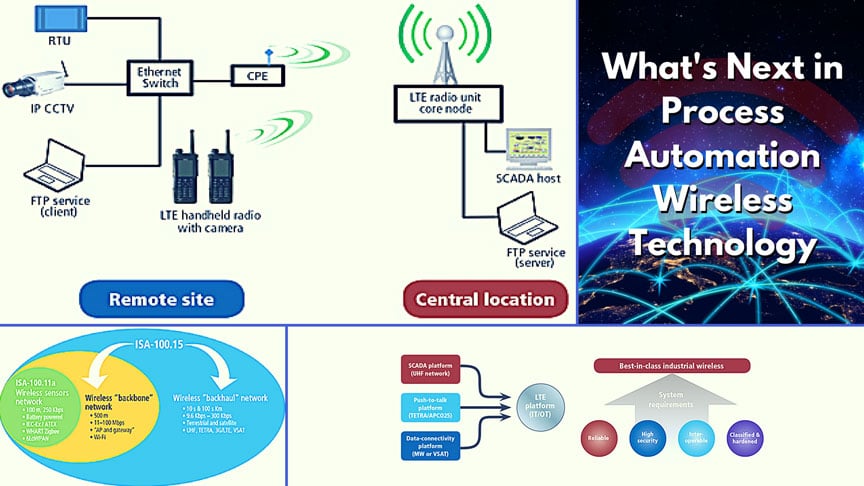
The new business operational needs required switching to broadband wireless technology for high-speed connectivity. Evolving SCADA technology continues to take advantage of emerging technologies at different layers, capitalizing on open standards and new technologies, enabling integrated services and functionality across wider areas. For example, intelligent field, closed-circuit television (CCTV), mobile radios with video streaming, and field computing applications became common information technology/operational technology (IT/OT) integrated services. Several backhaul wireless technologies were introduced to deliver specific services, such as voice, video, and data connectivity. This resulted in deploying various heterogeneous and fragmented wireless platforms. Furthermore, and despite the fact that wireless instrumentation standards were ratified more than five years ago, there are a limited number of certified wireless instrumentation devices that comply with WirelessHART or ISA-100.11a specifications. One major reason was the lack of synergy in the automation world to streamline standardization efforts and drive toward a converged wireless instrumentation protocol. End users were confused and hesitant to consider mass deployment of wireless instrumentation technology.
Wireless classifications
In general, industrial wireless technologies can be classified into three main categories based on their coverage area (figure 1):
- Wireless sensor networks: Dominated by ISA-100.11a, WirelessHART, ZigBee, and IPv6 over low-power wireless personal area network (6LoWPAN) technologies
- Wireless backbone networks: Dominated by IEEE 802.11a/b/g/n/ac Wi-Fi family
- Wireless backhaul networks: Dominated by UHF radio and evolving toward 4G long-term evolution (LTE), satellite (Ka-band VSAT), and microwave technology
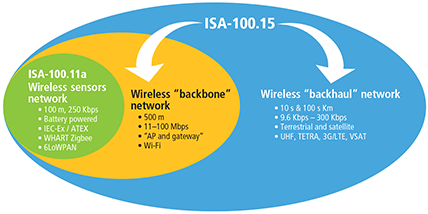 Figure 1. Industrial wireless systems classification
Figure 1. Industrial wireless systems classification
The ISA-100 standard groups wireless applications into three classifications: monitoring, control, and safety. Wireless technology might be used for monitoring and noncritical control applications related to Class 2 and Class 3, as shown in figure 2.
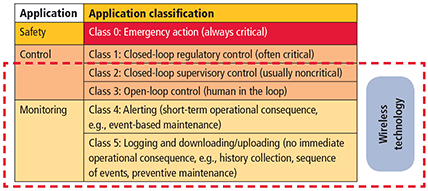 Figure 2. Wireless application classification
Figure 2. Wireless application classification
Industrial wireless system requirements
Channel reliability is a vital requirement for automation systems. In the old days, a simple parity check or cyclic redundancy check was used to detect errors and request retransmission. Technology has advanced with spread spectrum, forward error correction (FEC), adaptive code modulation, and intelligent power control mechanism. These boost channel reliability and compensate for possible attenuation caused by weather conditions or surrounding structures. In addition, redundant and dual-frequency transmission is becoming popular for plant backbone networks in the 2.4- and 5-gigahertz (GHz) frequency bands.
Security is one of the key challenges in the wireless domain, because air is a shared medium. ISA-100.11a and ISA-100.15 established the recommended security requirements for the confidentiality, privacy, and integrity of transmitted data. The hardware-based advanced encryption standard (AES-128 bit) and strong mutual authentication are key security requirements.
Standard-based radio is equally important to ensure compatibility among wireless components from different suppliers, generally referred to as interoperability. The ISA100 Wireless Compliance Institute was established to ensure products’ compliance and conformance to the established technical specifications and requirements against the ISA-100.11a standard. Other wireless standardization bodies also developed compliance frameworks and certifications to their specifications, such as WirelessHART, ZigBee, Wi-Fi, VSAT (DVB), and LTE.
For most plants’ applications, wireless devices are used in an outdoor hazardous environment. Therefore, systems should be designed with a proper explosion-proof level (classification) and ingress protection (hardened) (figure 3).
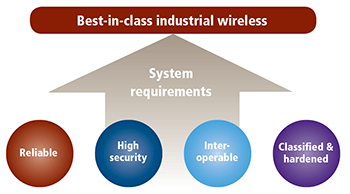 Figure 3. Best-in-class wireless model
Figure 3. Best-in-class wireless model
Technology evolution
Wireless sensor network
For the wireless sensor mesh networks, IEEE 802.15.4 is the core wireless sensor mesh standard (open systems interconnection [OSI] layers 1 and 2) used to derive the ZigBee, WirelessHART, ISA-100.11a, and 6LoWPAN network layers (layer 3+). End users in the oil and gas, utility, and automation industries dreamed of one common converged wireless sensor standard, which never materialized. It is in the best interest of the industry and end users to go for dual-mode gateways that can communicate with two or more wireless sensor protocols. The IEEE 802.11x (i.e., Wi-Fi family) is a good example, where different protocols are served by one Wi-Fi gateway (i.e., a, b, g, n, and ac flavors).
The Internet of Things (IoT), big data analytics, and cloud computing are creating a paradigm shift in the wireless sensor domain. The 6LoWPAN seems to be in a better position to integrate seamlessly and participate efficiently in the IoT domain, as it was built with native IPv6 capabilities.
Wireless backbone network
Industrial Wi-Fi is the core building block for a plant’s backbone interconnectivity. The technology kept pushing the bandwidth envelope to support 1 gigabit per second and more by using wider spectrum bandwidth, more complex modulation, and advance multiple-input and multiple-output techniques. Moreover, beam forming, FEC, and concurrent dual-band transmission (i.e., 2.4 and 5 GHz) enhanced industrial Wi-Fi reliability and resiliency. In general, an industrial Wi-Fi router is usually integrated with a wireless sensor network to form a plant wireless cell that seamlessly interconnects field sensor devices with the plant control domain.
Wireless backhaul network
Long range, or last mile, wireless technology is a vital connectivity solution for the field operations spread across large geographical areas. In the “old days,” and even today, UHF radios were used as narrowband connectivity for field RTUs via low-speed serial interface (RS-232) radio channels. The recent advancements in SCADA, intelligent field, CCTV, video-enabled mobile radios, and other applications drive IT business managers to adopt newer wireless technologies for higher data speeds.
In addition, several oil and gas end users capitalize on push-to-talk voice services (TETRA or APCO-25) in support of field operations. On top of that, satellite network (VSAT) or microwave is also deployed to deliver high-speed data connectivity at remote sites.
IT/OT convergence is driving businesses to optimize infrastructure, reduce operational costs, and maximize capabilities and integration. LTE is one of the latest wireless technologies developed for mobile and fixed applications. Although it originated as the fourth-generation cellular network, this technology poses great opportunity for industrial applications due to economy of scale, ample bandwidth, and low latency. LTE technology has the potential to transform the above-mentioned fragmented backhaul wireless services (figure 4).
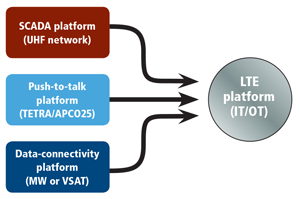 Figure 4. Backhaul wireless services envisaged convergence
Figure 4. Backhaul wireless services envisaged convergence
LTE wireless technology
We conducted a proof-of-concept (POC) trial to test and evaluate the use of LTE wireless technology for plant systems and applications. The POC was conducted in a lab environment using a time-division, long-term evolution (TD-LTE) radio system, which operates at 1.8 GHz. It was configured with a 20-megahertz (MHz) channel bandwidth.
The different testing scenarios were:
- Testing pure SCADA channel
- Testing SCADA with concurrent CCTV stream
- Testing SCADA with concurrent CCTV stream and 50 percent FTP traffic channel loading
- Testing SCADA with concurrent CCTV stream and maximum FTP traffic (stress test)
The SCADA RTU was configured with DNP3 interface, 1-millisecond (ms) scanning resolution, and 1-second polling cycle. In addition, a fixed high-resolution (HD) camera, FTP services, and push-to-talk with video streaming were used concurrently (figure 5).
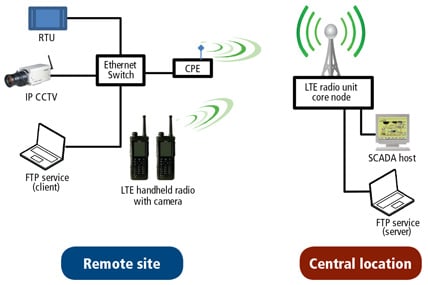 Figure 5. Lab test setup
Figure 5. Lab test setup
The system delivered 90 megabits per second (Mbps) throughput, under the LTE SA2 data subframe structure configuration (DL:UL = 3:1). For the SA0 subframe structure configuration (DL:UL = 1:3), the system delivered 49.2 Mbps throughput, with very low latency (17 ms).
The LTE platform is flexible, scalable, and agile. It supports transmission of different services while maintaining a guaranteed bit rate (GBR) for specific industrial applications, such as SCADA and machine to machine, that are usually time sensitive. Although HD CCTV, FTP, and push-to-talk services were running simultaneously, SCADA traffic was not affected by the wireless loading, as it was configured with GBR that resulted in reliable communication and low latency (20 ms) under the stress-test scenario.
IT/OT integration and convergence
The POC demonstrated that the LTE wireless platform could serve multiple concurrent applications and fulfill SCADA requirements by allocating required resources. Low latency, high bandwidth, advanced security, and guaranteed bandwidth make it a potential platform for industrial users (oil and gas, utility, etc.) serving voice, broadband data, and CCTV applications.
Further field assessment is needed to conclude the potential value of LTE technology for industrial applications. Frequency licensing is a common challenge for wireless technologies. Luckily, the LTE standard supports different frequency bands. The 700-MHz band (i.e., TV whitespace spectrum) seems to be the best option. It has better signal propagation characteristics for longer reach and better signal reception.
In short, wireless technology has become an essential business enabler for industrial automation and other domains. It will play a vital role in establishing and promoting IoT, big data analytics, and cloud computing. Furthermore, LTE wireless technology can transform the current fragmented islands of backhaul wireless networks and deliver a unified backhaul platform that supports voice, video, and data reliably, securely, and cost effectively. To capture this opportunity, an extra collaboration between IT and automation businesses is required to standardize common wireless platforms and drive seamless IT/OT integration and convergence.
About the Author
Soliman A. Al-Walaie is a communication engineering consultant in the process and control systems department of Saudi Aramco with more than 18 years of experience in industrial networks and IT technologies.
A version of this article also was published at InTech magazine.



